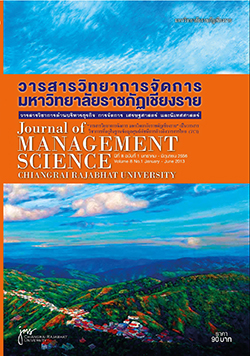Semiotic Approaches Served for Customers’ Experiences in OASIS Spa Business in Chiang Mai Branch
Main Article Content
Abstract
This study aimed to investigate the communication process to manage customer experience of Oasis Spa, Chiang Mai Branch based on theoretical concepts including Marketing Communication, Customer Experience Management, and Semiotics. This qualitative study used structured interview and non-participatory observation as a means to collect the data. Content Analysis was employed to analyze the qualitative data. The findings showed that : Oasis Spa, Chiang Mai Branch incorporated physical and psychological strategies using outstanding features of Lanna arts and cultures as well as gentle, simple, and charming lifestyles of Lanna people. The Lanna identities were employed by means of semiotics to empower the communication with the customers for positive experience, brand satisfaction, and brand loyalty purposes. In addition, the results indicated that Oasis Spa divided the customer experience into five categories, that is, People, Product, Price, Place, and Promotion. For the people domain, the staff showed physical communication through face and body gestures, friendly smile, courtesy and tactile manner in order to build friendly, warm, and sincere human relationship experience for the customer. For the product domain, the concentration was on the Lanna identity, a distinct feature making it different from products of other socio-cultural areas. The products demonstrating Lanna features included unique massage gestures, special-formula massage oil, and specially composed music. The product under this theme led the customers to the new kind of experience with reliable and confident atmosphere as well as relaxing and stimulating exposure. For the place domain, the spa décor focused on Lanna identity incorporating woodworks, Lanna textiles, and Lanna umbrella. The design on Lanna theme including a wooden house depicting the lifestyle of suburb local people, Lanna music, fragrance of herbs and aroma oil, staff dressed in green underscored semiotics that led the customer to peaceful, cool, pleasant, awesome, warm, and relaxed experience and sensation of body and mind. For the price domain, the holistic design of Oasis Spa was aimed to communicate the rewarding experience for the customer in that the price was worth the service as well as the recognition the customer’s image. Oasis Spa employed several forms of Marketing Communication including Advertising, Public Relations, Sales Promotion, Roadshow, Event Marketing, and Membership. These activities were incorporated with an aim to build positive attitudes, confidence towards the spa house, and rewarding service for the customer.
Article Details
Views and opinions expressed in the journal do not necessarily reflect those of the editors.


